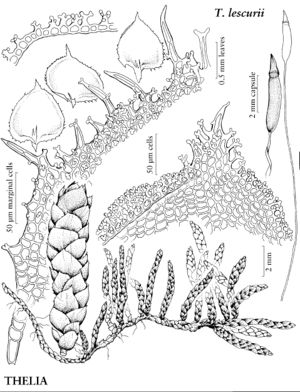Theliaceae
Plants in dense mats, bluish gray, yellowish gray, or dark green, glaucous. Stems creeping or ascending, often densely tomentose; epidermal-cells small, walls firm to thick, cortical cells enlarged, central strand present; paraphyllia subfoliose or absent; pseudoparaphyllia filamentous or foliose-ciliate; rhizoids from clusters of initials abaxial to leaf insertions; axillary hairs of 3–6 cells, basal-cell subrectangular, reddish-brown, distal cells oblong, hyaline. Stem and branch leaves occasionally dimorphic; densely foliate, erect-appressed or imbricate when dry, erect-swollen when moist, concave. Sexual condition phyllodioicous; dwarf males on tomentum or leaves of female plants. Seta elongate. Capsule erect; stomata present; peristome diplolepidous. Calyptra cucullate, smooth, naked.
Distribution
North America, ne Mexico, West Indies (Dominican Republic)
Discussion
Genus 1, species 3 (3 in the flora).
Theliaceae consists of small plants in dense, often extensive mats. The leaves have a single costa, short, stout 1-papillose laminal cells, and well-differentiated alar cells. Some members of the group have subfoliose paraphyllia; some also have foliose-ciliate pseudoparaphyllia. The setae are long, capsules erect and more or less symmetric; the exostome teeth are narrow and smooth basally, but otherwise papillose; endostomes are rudimentary; and calyptrae are cucullate. There has been considerable controversy over the systematic position of Thelia, with the genus variously placed in Anomodontaceae, Hylocomiaceae, Leskeaceae, Theliaceae, or Thuidiaceae, through the classical dilemma of gametophytic features indicating one relationship and sporophytic features pointing to another. Thelia was revised by H. A. Crum (1966); he noted the genus was gametophytically similar to Thuidiaceae but had the sporophyte, especially the peristome structure, of Anomodon. Crum placed Thelia in Thuidiaceae by its differentiated stem leaves, polymorphous, ciliate paraphyllia, and stout, curved papillae. W. R. Buck and D. H. Vitt (1986) placed Thelia in Anomodontaceae on the basis of short laminal cells with well-developed papillae and narrow, white, papillose exostome teeth. There is good molecular support (Chiang T. Y. and B. A. Schaal 2000, 2000b) for placing Thelia in Hylocomiaceae. B. Goffinet and W. R. Buck (2004) and Goffinet et al. (2008) placed Thelia in Theliaceae because of questions concerning the sample size of the molecular study.
Selected References
None.
Lower Taxa
Illustrations
| Family ⠉ | Taxon | Illustrator ⠉ | |
|---|---|---|---|
 | Theliaceae | Thelia lescurii | Patricia M. Eckel |